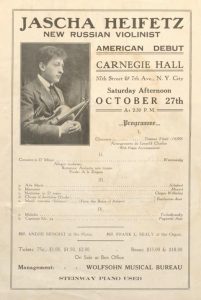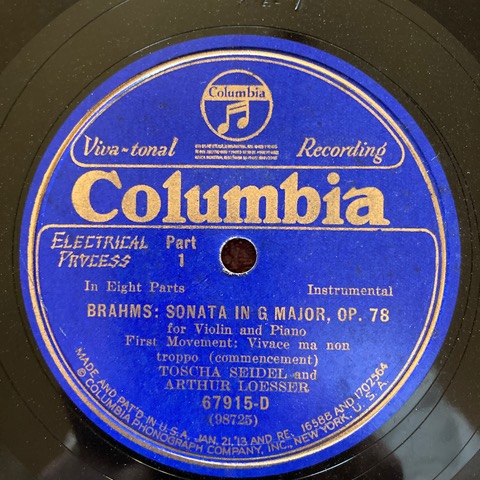
The “Da Vinci” Stradivari and Toscha Seidel
Few may know of violinist TOSCHA SEIDEL (1899-1962), but he’s earned some press coverage lately due to the upcoming sale of his “Da Vinci” Stradivari violin of 1714. Seidel’s “Da Vinci” is the most notable violin to be offered publicly since the Lady Blunt Stradivari, which sold for $15.9 million in 2011. By the time the bidding on Tarisio Auctioneers’ website closes on June 9th, the “Da Vinci” may have set a new auction record for the selling price of a musical instrument.

Famous violinists and their violins are often inextricably linked. A violin’s importance can often be enhanced by its connection to a historic violinist. Although Seidel may be a cult hero among a select group of violin lovers, his public legacy has languished in relative obscurity for decades. The pending sale of the “Da Vinci” Stradivari has revived interest in the nearly forgotten violinist who once performed on it.
Heifetz’s Long Shadow
Toscha Seidel was born in Odesa, Ukraine, in 1899. As a young violinist, he made his way to St Petersburg to study with the legendary violin professor Leopold Auer. Auer trained many of the 20th century’s greatest luminaries of the violin, including Mischa Elman, Nathan Milstein, and, most notably, Jascha Heifetz.

Less than a year after Heifetz had conquered the US at his 1917 debut in New York, Seidel made his own New York debut. But Heifetz was a tough act to follow. Although Seidel enjoyed some success and notoriety, his career was forever overshadowed by Heifetz’s. In the 1920s he emigrated to the United States, where he continued to perform and record standard repertoire into the 1930s. Seidel was given his own weekly show on the CBS Radio Network, The Toscha Seidel Program, and was frequently featured as a soloist on broadcasts with the CBS Symphony.
The Gold Standard for Hollywood
By the late 1930s, Siedel had moved to Los Angeles to take on work for the major motion picture studios. Seidel’s violin performances in iconic films from the Golden Age of Hollywood made a lasting impression on the American psyche, even if his name was no longer prominent. Seidel’s burnished violin solos supercharged the soundtracks of films such as Intermezzo (1939), The Wizard of Oz (1939), and Around the World in Eighty Days (1956). Some regard Seidel’s rich, warm tone and intense vibrato as the model for the “Hollywood” sound. Seidel’s playing in Hollywood set the standard for other Hollywood concertmasters such as Louis Kaufman, Felix Slatkin, and Israel Baker.

Authenticity and Individuality
Seidel’s performances of standard repertoire reveal an affecting side of his artistry less often encountered. Seidel’s playing has the polish and bravura associated with the Auer class and along with his own highly individual and personal portamento and bow shadings. Seidel’s unique tone, eloquence, and poetry speak to a kind of authenticity and individuality in performance missing in the generations of violinists that have followed.
An Unhappy Ending
As brilliant and authentic as Seidel’s playing was, his story didn’t have a happy ending. As he aged, he developed a neurological condition that affected his playing. His physical decline, the end of the golden age of Hollywood, and Seidel’s business naivete all caught up with the once-bright star. He ended his career playing in pit orchestras in Las Vegas until his death in obscurity in 1962, at the age of 62.
Coda
Long-time Guarneri Hall friend and supporter Adam Dubin is a true devotee of past musical masters. Adam has gone to the trouble of mastering Seidel’s performance of Brahms Sonata #1 and has generously allowed us to post the results of his efforts here. With or without the millions it will take to buy Seidel’s Stradivari, this Brahms recording brings us closer to Seidel’s playing at his best. And one can hope that the sale of Seidel’s Stradivari violin will help a new crop of violin-lovers discover this magical and under-appreciated artist from a bygone era.

Violin Sonata No.1 in G, Op.78
Toscha Seidel, violin/Arthur Loesser, piano
Columbia 67916-D/67918-D (matrices 98725/98732; recorded in 1931)
Part 1
Part 2
Part 3

